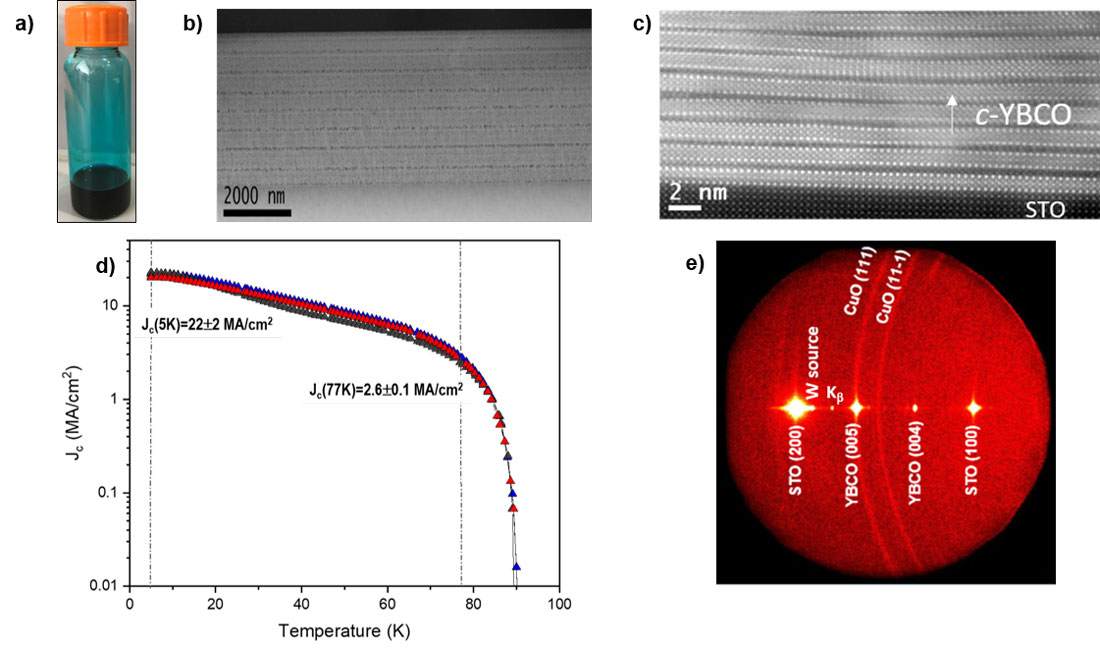WB9-8
Novel class of metalorganic fluorine-free solutions for tunable liquid composition in the Transient Liquid Assisted Growth of high performance superconducting YBa2Cu3O7-x films
Dec. 1 18:55-19:10
*Lavinia Saltarelli1, Kapil Gupta1, Silvia Rasi1, Aiswarya Kethamkuzhi1, Diana Garcia1, Jordi Aguilar1, Elzbieta Pach1, Daniel Sanchez-Rodriguez2, Jordi Farjas2, Cristian Mocuta3, Eduardo Solano4, Joffre Gutierrez1, Susagna Ricart1, Xavier Obradors1, Teresa Puig1
Institut de Ciència de Materials de Barcelona, Superconducting Materials and Large Scale Nanostructres, Bellaterra, Spain1
University of Girona, GRMT, Department of Physics, Girona, Spain2
Diffabs beamline, Soleil Synchrotron, Paris, France3
NCD-Sweet beamline, ALBA Synchrotron, Cerdanyola del Vallès, Barcelona, Spain4
High temperature superconductors (HTS) are unique materials to transport high electrical currents without losses up to liquid nitrogen temperatures and/or at high magnetic fields. Therefore, substantial research was promoted to demonstrate their opportunities towards efficient electrical transport and high field magnets applications. However, the high production costs of the existing technology refrain their market out-breaking. Chemical solution deposition (CSD) techniques have decisively opened possibilities for the manufacturing of low-cost nanostructured epitaxial HTS superconductors with high performances, successfully employing trifluoroacetate metal-organic precursors (TFA-route). We have developed a high-throughput growth method, the Transient Liquid Assisted Growth (TLAG), that enables to reach growth rates up to 1000 nm/s [1,2] compatible with a CSD methodology. Additionally, since it uses a fluorine-free solution approach, it follows the global need for greener chemical processes to grow epitaxial YBa2Cu3O7 (YBCO) superconducting films. We designed a robust environmentally friendly propionate-based metalorganic solution using a facile low cost synthetic method which ensures a 50% higher metal concentration and very high stabilization, starting from low-cost commercial precursors [3]. This solution facilitates the preparation of highly homogeneous nanocrystalline pyrolysis layers with very low porosity (1-2 %) at least up to a thickness of 2.7 μm, resulting in the ultrafast growth of reproducible YBCO epitaxial layers of 2.5-3 MA/cm2 at 77 K. Solution rheological characterization together with EPR, TGA and TEM analysis were key to obtain thick films without compromising their homogeneity [3]. Moreover, this novel preparation method is compatible with the possibility of varying the Ba/Cu molar ratio in solutions, allowing us to optimize solutions of various compositions with desired features for TLAG. The use of various liquid compositions results in a modification of the supersaturation conditions and characteristics of the transient liquid in the TLAG process, through which we can evince the differences in nucleation, epitaxy and physical properties. Employing in-situ XRD synchrotron radiation and HRTEM/STEM, we could reach a wide understanding of the TLAG mechanism by identifying the relevance of the kinetic behavior, the influence of the transient liquid composition and the correlation with the superconducting properties.
References
[1] Soler, L., Jareño, J., Banchewski, J. et al. Ultrafast transient liquid assisted growth of high current density superconducting films. Nat Commun 11, 344 (2020). https://doi.org/10.1038/s41467-019-13791-1
[2] Rasi, S., Queraltó, A., Banchewski, J., Saltarelli, L., Garcia, D., Pacheco, A., Gupta, K., Kethamkuzhi, A., Soler, L., Jareño, J., Ricart, S., Farjas, J., Roura-Grabulosa, P., Mocuta, C., Obradors, X., Puig, T., Kinetic Control of Ultrafast Transient Liquid Assisted Growth of Solution-Derived YBa2Cu3O7-x Superconducting Films. Adv. Sci. 2022, 2203834. https://doi.org/10.1002/advs.202203834
[3] Saltarelli, L., Gupta, K., Rasi, S., Kethamkuzhi, A., Queraltó, A., Garcia, D., Gutierrez, J., Farjas, Roura, P., Ricart, S., Obradors, X., Puig, T., Chemical and microstructural nanoscale homogeneity in superconducting YBa2Cu3O7-x films derived from metal-propionate fluorine-free solutions, submitted.
Keywords: YBCO superconducting films, chemical solution deposition, transient liquid assisted growth, in-situ XRD synchrotron characterization
